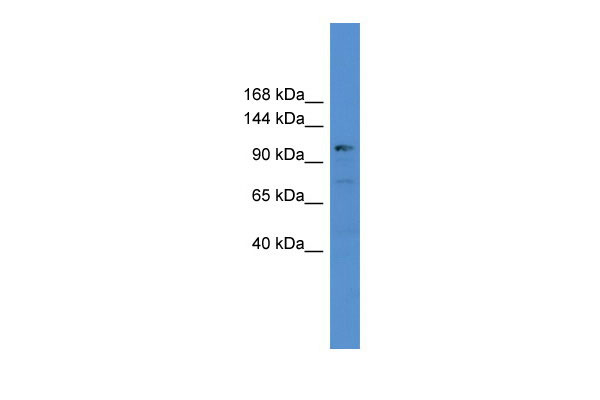USP35 antibody - C-terminal region
Rabbit Polyclonal Antibody
- SPECIFICATION
- CITATIONS
- PROTOCOLS
- BACKGROUND

Application
| WB |
|---|---|
| Primary Accession | Q9P2H5 |
| Other Accession | NM_020798, NP_065849 |
| Reactivity | Human, Mouse, Rat, Rabbit, Goat, Horse, Yeast, Bovine, Dog |
| Predicted | Human, Rat, Rabbit, Bovine, Dog |
| Host | Rabbit |
| Clonality | Polyclonal |
| Calculated MW | 113kDa |
| Gene ID | 57558 |
|---|---|
| Other Names | Ubiquitin carboxyl-terminal hydrolase 35, 3.4.19.12, Deubiquitinating enzyme 35, Ubiquitin thioesterase 35, Ubiquitin-specific-processing protease 35, USP35, KIAA1372, USP34 |
| Format | Liquid. Purified antibody supplied in 1x PBS buffer with 0.09% (w/v) sodium azide and 2% sucrose. |
| Reconstitution & Storage | Add 50 ul of distilled water. Final anti-USP35 antibody concentration is 1 mg/ml in PBS buffer with 2% sucrose. For longer periods of storage, store at 20°C. Avoid repeat freeze-thaw cycles. |
| Precautions | USP35 antibody - C-terminal region is for research use only and not for use in diagnostic or therapeutic procedures. |
| Name | USP35 |
|---|---|
| Synonyms | KIAA1372, USP34 |
| Function | Deubiquitinase that plays a role in different processes including cell cycle regulation, mitophagy or endoplasmic reticulum stress (PubMed:26348204, PubMed:29449677, PubMed:37004621). Inhibits TNFalpha-induced NF-kappa-B activation through stabilizing TNIP2 protein via deubiquitination (PubMed:26348204). Plays an essential role during mitosis by deubiquitinating and thereby regulating the levels of Aurora B/AURKB protein (PubMed:29449677). In addition, regulates the protein levels of other key component of the chromosomal passenger complex (CPC) such as survivin/BIRC5 or Borealin/CDCA8 by enhancing their stability (PubMed:34438346). Regulates the degradation of mitochondria through the process of autophagy termed mitophagy (PubMed:25915564). |
| Cellular Location | Cytoplasm. Mitochondrion. Note=Only associates with polarized mitochondria, and rapidly translocates to the cytosol during mitophagy. |
| Tissue Location | Expressed in testis, pancreas and skeletal muscle. |

Thousands of laboratories across the world have published research that depended on the performance of antibodies from Abcepta to advance their research. Check out links to articles that cite our products in major peer-reviewed journals, organized by research category.
info@abcepta.com, and receive a free "I Love Antibodies" mug.
Provided below are standard protocols that you may find useful for product applications.
References
Quesada V.,et al.Biochem. Biophys. Res. Commun. 314:54-62(2004).
Nagase T.,et al.DNA Res. 7:65-73(2000).
Taylor T.D.,et al.Nature 440:497-500(2006).
Dephoure N.,et al.Proc. Natl. Acad. Sci. U.S.A. 105:10762-10767(2008).
If you have used an Abcepta product and would like to share how it has performed, please click on the "Submit Review" button and provide the requested information. Our staff will examine and post your review and contact you if needed.
If you have any additional inquiries please email technical services at tech@abcepta.com.













 Foundational characteristics of cancer include proliferation, angiogenesis, migration, evasion of apoptosis, and cellular immortality. Find key markers for these cellular processes and antibodies to detect them.
Foundational characteristics of cancer include proliferation, angiogenesis, migration, evasion of apoptosis, and cellular immortality. Find key markers for these cellular processes and antibodies to detect them. The SUMOplot™ Analysis Program predicts and scores sumoylation sites in your protein. SUMOylation is a post-translational modification involved in various cellular processes, such as nuclear-cytosolic transport, transcriptional regulation, apoptosis, protein stability, response to stress, and progression through the cell cycle.
The SUMOplot™ Analysis Program predicts and scores sumoylation sites in your protein. SUMOylation is a post-translational modification involved in various cellular processes, such as nuclear-cytosolic transport, transcriptional regulation, apoptosis, protein stability, response to stress, and progression through the cell cycle. The Autophagy Receptor Motif Plotter predicts and scores autophagy receptor binding sites in your protein. Identifying proteins connected to this pathway is critical to understanding the role of autophagy in physiological as well as pathological processes such as development, differentiation, neurodegenerative diseases, stress, infection, and cancer.
The Autophagy Receptor Motif Plotter predicts and scores autophagy receptor binding sites in your protein. Identifying proteins connected to this pathway is critical to understanding the role of autophagy in physiological as well as pathological processes such as development, differentiation, neurodegenerative diseases, stress, infection, and cancer.


